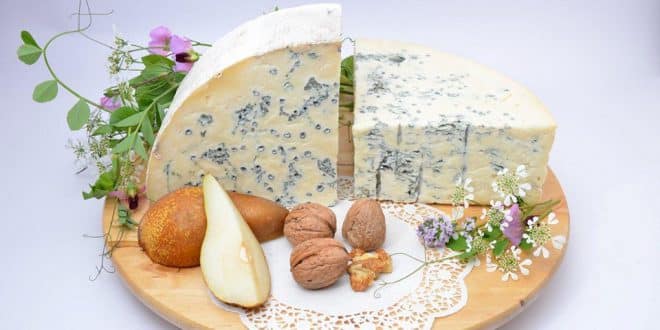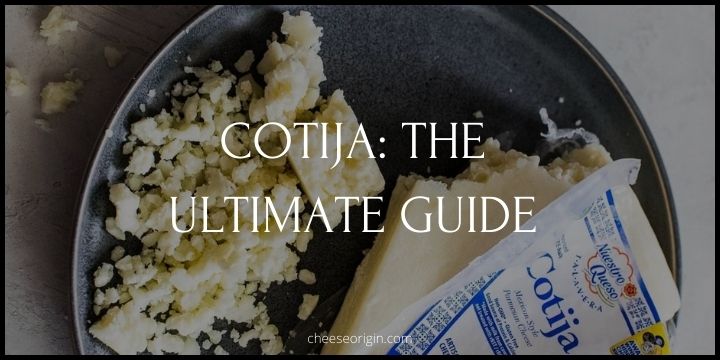What is Gorgonzola? A Guide to Italy’s Beloved Blue Cheese

Welcome to our culinary journey into the world of cheese, where we’ll be delving deep into the rich and creamy universe of Gorgonzola.
This Italian blue cheese, renowned for its distinctive flavor and texture, is a favorite among cheese connoisseurs and foodies worldwide.
Whether you’re an avid cheese enthusiast or a curious novice looking to expand your cheese horizons, our comprehensive guide will offer you a fascinating insight into everything Gorgonzola.
From its ancient origins, production process, to pairing suggestions and cooking tips, we’ll explore all the facets of this beloved cheese.
So, sit back, grab a slice of crusty bread, and join us as we embark on this flavorful adventure into the world of Gorgonzola.
Quick Facts About Gorgonzola
| Fact | Description |
|---|---|
| Origin | Italy |
| Milk Source | Cow’s milk |
| Texture | Crumbly and soft for young Gorgonzola (Dolce), firm for mature Gorgonzola (Piccante) |
| Flavor | Mild to sharp, slightly sweet to very tangy depending on age |
| Color | White or pale yellow with distinctive blue or green veins |
| Aging Process | 3-4 months for Dolce, over 6 months for Piccante |
| Protected Designation of Origin | Registered as a Protected Designation of Origin (PDO) under EU law since 1996. The Consortium For The Protection Of Gorgonzola PDO Cheese was established in May 14, 1970. |
| Historical Origins | The cheese is believed to have been created around the year 879. |
| Uses | Cheese boards, salads, pasta dishes, melted in cooking |
What is Gorgonzola?
Gorgonzola is a type of blue cheese that originated in Italy. It’s named after the town of Gorgonzola near Milan, where it was first produced centuries ago. The cheese is typically pale white to straw-colored with characteristic blue-green veins. These veins are produced by mold spores and give the cheese its distinctive appearance and flavor.
There are two main types of Gorgonzola – Dolce (sweet) and Piccante (spicy). Gorgonzola Dolce is a younger, softer cheese with a sweet, creamy, and slightly pungent taste. On the other hand, Gorgonzola Piccante is an older, firmer cheese with a more intense, sharp flavor.
Gorgonzola is aged for varying lengths of time. Gorgonzola Dolce is typically aged for 2-3 months, while Gorgonzola Piccante is aged for over three months, often up to a year.
This cheese pairs well with a variety of foods and wines. It can be melted into risotto, served with pasta, or crumbled over salads. Sweeter wines like Moscato d’Asti or Port often complement Gorgonzola’s flavor profile.
How Do Italians Eat Gorgonzola?

In Italy, the consumption of Gorgonzola cheese is as much about tradition as it is about flavor.
Italians often savor Gorgonzola in its unadulterated form, appreciating its unique tangy and nutty profile.
It is typically served at room temperature to allow its characteristic creaminess to shine, and is frequently paired with a slice of crusty bread or a drizzle of honey.
Gorgonzola also finds its way into a range of Italian dishes, from risottos and pastas to salads and pizzas.
And no Italian cheese platter is complete without this blue-veined delight.
Whether in the bustling streets of Milan or the rustic kitchens of Piedmont, Gorgonzola is enjoyed with a reverence for tradition that is quintessentially Italian.
The 6 Best Way to Eat Gorgonzola
- On a Cheese Board: Gorgonzola’s distinctive flavor makes it an excellent choice for a cheese board. Pair it with fresh fruits like pears and figs, nuts such as walnuts or pecans, and honey or jams. Complement these with crusty bread or gourmet crackers.
- In Pasta Dishes: This cheese melts beautifully, making it perfect for creamy pasta sauces. Combine it with cream, garlic, and parmesan for a rich and tangy sauce that pairs well with pastas like gnocchi, fettuccine, or penne.
- In Salads: Crumble Gorgonzola over salads for a burst of flavor. It pairs particularly well with mixed greens, roasted beets, walnuts, and a sweet vinaigrette.
- On Pizza: Can be an excellent topping for pizza. Pair it with caramelized onions, pears, or prosciutto for a gourmet twist.
- With Wine: Pairs beautifully with a range of wines. Try it with sweet wines like Sauternes or Port, or bold, full-bodied reds like Cabernet Sauvignon.
- In Baked Goods: This cheese can be incorporated into various baked goods like scones, biscuits, and bread for a savory treat.
Also read: Best Wine and Cheese Pairings: The Ultimate Guide
The 2 Different Types of Gorgonzola
There are primarily two types of Gorgonzola cheese, each with its unique characteristics:
| Type | Other Names | Age | Texture | Flavor | Rind | Veining |
|---|---|---|---|---|---|---|
| Gorgonzola Dolce (Sweet Gorgonzola) | Gorgonzola Cremificato | 2-3 months | Soft, Creamy | Sweet, Mild, Slightly Tangy | Thin, Moist | Subtle Blue |
| Gorgonzola Piccante (Spicy Gorgonzola) | Gorgonzola Naturale, Gorgonzola Montagna, Mountain Gorgonzola | 6+ months | Firmer | Sharp, Robust, Slightly Pungent | Dry, Crumbly | Pronounced Blue |
Both types are made with pasteurized cow’s milk and contain the distinctive blue-green molds that give Gorgonzola its characteristic appearance and flavor.
Is it Recommended to Eat Gorgonzola by itself?
Yes, you can certainly eat Gorgonzola cheese by itself. Its rich, creamy texture and unique flavor profile make it a delight to savor on its own.
However, to fully appreciate the complexities of its taste, it’s often recommended to let the cheese come to room temperature before consuming, as this allows its full flavor to shine through.
Gorgonzola also pairs beautifully with a variety of foods and beverages, from fruits and honey to wine and bread, which can further enhance its flavor.
But ultimately, how you choose to enjoy Gorgonzola is up to your personal preference.
Also read: 11 Best Crackers that Pair Well with Cheese
What does Gorgonzola pair well with?
- Fruits: Pears, apples, figs, and grapes complement the rich flavors of Gorgonzola.
- Nuts: Walnuts, almonds, or pecans can add a nice crunch and contrast to the creaminess of the cheese.
- Bread/Crackers: Crusty bread, baguettes, or artisan crackers are excellent choices.
- Honey: Drizzling honey over Gorgonzola creates a beautiful balance of sweet and savory.
- Wine: Full-bodied red wines like Cabernet Sauvignon or Zinfandel, or sweet white wines like Sauternes or Moscato d’Asti, pair nicely.
- Charcuterie: Salty cured meats like prosciutto balance out the intense flavor of the cheese.
- Salads: Gorgonzola can be crumbled over salads, especially those with a sweet element such as dried cranberries or pears.
- Pasta: It melts well and can be used in pasta sauces, particularly with gnocchi or penne.
Also read: What Fruit Goes on a Charcuterie Board?
Are Gorgonzola and Blue Cheese the Same?
Sure, here is a simple table to illustrate the differences between Gorgonzola and general blue cheese:
| Gorgonzola | Blue Cheese | |
|---|---|---|
| Origin | Italy | Varies depending on type (e.g., France for Roquefort, England for Stilton) |
| Texture | Can range from soft and creamy (Dolce or Sweet Gorgonzola) to crumbly and firm (Gorgonzola Piccante) | Varies depending on type, can range from soft to crumbly |
| Flavor | Mild to sharp, sweet, nutty | Varies depending on type, generally tangy, strong, pungent |
| Color | Pale yellow with blue-green veins | Generally white/cream with blue veins, but can vary |
| Aging | Dolce is aged for about 2 months, Piccante is aged for 3-4 months or more | Varies depending on type, Roquefort is aged for about 5 months, Stilton is aged for 9 weeks to a year |
While Gorgonzola is a type of blue cheese, not all blue cheeses are Gorgonzola.
Blue cheese is a general term for cheeses that have had cultures of the mold Penicillium added, resulting in spots or veins of blue, blue-gray or blue-green mold throughout the cheese.
Gorgonzola is a specific variety of blue cheese, originating from Italy, and is known for its crumbly texture and nutty aroma.
Other types of blue cheese include Roquefort, Stilton, and Danish Blue, each with their own unique characteristics and flavor profiles.
Is Gorgonzola Blue Cheese Healthy?
Gorgonzola is healthy for most people when consumed in moderation. Here are several health benefits associated with Gorgonzola:
- Anti-Inflammatory Properties: A protein fraction found in Gorgonzola has been shown to decrease inflammation.
- Rich in Essential Nutrients: Gorgonzola is high in potassium, phosphorus, and sodium. It’s also rich in vitamin B12 and provides a good source of healthy fats like omega-3 fatty acids.
- Weight Management: Gorgonzola is low in calories and carbs and offers a moderate amount of protein and fat per ounce, which can support weight management.
- Gut Health: The mold cultures in Gorgonzola can act as a natural antibacterial and benefit the intestinal flora.
- Bone Health: Blue cheese, including Gorgonzola, is rich in calcium, essential for healthy teeth and bones.
Source:
Gorgonzola Nutrition Facts
The key nutrients in a 100 grams serving of Gorgonzola cheese:
| Nutrient | Quantity |
|---|---|
| Calories | 353 kcal |
| Protein | 19g |
| Total Fat | 29g |
| Saturated Fat | Not Specified |
| Cholesterol | Not Specified |
| Sodium | 326mg |
| Potassium | Not Specified |
| Total Carbohydrate | 0.7g |
| Dietary Fiber | 0g |
| Sugars | 0g |
The Battle of Blue Cheese: Roquefort vs. Gorgonzola
| Comparison Factors | Roquefort | Gorgonzola |
|---|---|---|
| Country of Origin | France | Italy |
| Milk Used | Sheep’s milk | Cow’s milk |
| Texture | Generally crumbly and moist | Comes in two varieties: Dolce (soft and creamy) and Piccante (firm and crumbly) |
| Taste | Bold, tangy and slightly sour | Mild to sharp, depending on the variety. Dolce is sweet and creamy while Piccante is stronger and spicier |
| Color | White with blue-green veins | Pale yellow with blue-green veins |
| Aging period | Minimum of 3 months, usually 5 months | Dolce is aged for 2-3 months, Piccante is aged for over 3 months |
| Pairings | Traditionally paired with figs and nuts, or melted into sauces | Pairs well with honey, pears, walnuts, and hearty red wines |
| Health Benefits | High in protein, calcium and beneficial bacteria but also high in sodium and fat | Similar to Roquefort, it’s rich in protein, calcium, beneficial bacteria, and also high in sodium and fat |
In terms of health benefits, both cheeses have similar profiles.
They are rich in protein, calcium, and beneficial bacteria. However, they also tend to be high in sodium and fat, so consumption should be moderated.
Ultimately, the “better” cheese is subjective and depends on your individual taste preferences, dietary needs, and the specific flavors you’re looking to pair in your meals.
A Simple Guide to Making Authentic Gorgonzola Cheese
Essential Ingredients: To make Gorgonzola cheese, you need the following ingredients:
- Whole cow’s milk
- Specific strains of bacteria (starter cultures)
- Calf rennet
- Penicillium glaucum spores
Also read: What is Rennet in Cheesemaking?
Tools Required: The tools required to produce authentic Gorgonzola cheese include:
- Large stainless steel pot
- Cheese mold
- Cheese mat
- Long knife (for cutting the curd)
- Cheese needles (for piercing)
Also read: Top 19 Home Cheesemaking Equipment & Tools
Environmental Variables: Making Gorgonzola cheese requires control over certain environmental variables like temperature and humidity. The cheese must be kept at a constant temperature of around 48-50°F (9-10°C) during the ripening process. Humidity levels should also be kept high (around 90-95%) to prevent the cheese from drying out.
Primary Stages in the Process:
- Inoculation: The process begins by heating the milk and then adding the starter cultures and Penicillium glaucum spores. These are mixed thoroughly before calf rennet is added to coagulate the milk into a solid mass.
- Cutting the Curd: Once the milk has coagulated, the solid mass is cut into small pieces using a long knife. This helps to separate the curds from the whey.
- Molding and Pressing: The curds are then transferred into a cheese mold where they are pressed to remove any remaining whey and help the curds knit together.
- Salting: The cheese is then salted. This step enhances the flavor and helps to preserve the cheese.
- Piercing: After a few days, the cheese is pierced with needles. This allows air to enter the cheese and facilitates the growth of the blue mold.
- Ripening: The cheese is then left to ripen for several months. During this time, it develops its unique flavor and texture.
Also read: 9 Simple Steps of Home Cheesemaking
Considerations and Variations: The length of the aging process can affect the flavor and texture of the Gorgonzola cheese. A younger Gorgonzola, known as Dolce or Sweet, is aged for less than three months, has a softer texture and milder flavor. Gorgonzola Piccante or Mountain Gorgonzola, is aged for more than three months and has a firmer texture and stronger flavor.
Final Product: A well-made Gorgonzola cheese is a sight to behold. Its creamy white color is streaked with bluish-green veins of mold. The texture can range from crumbly to buttery depending on the aging process. The taste is rich and complex, with a sharpness from the blue veins contrasting beautifully with the creaminess of the cheese.
Remember, while making Gorgonzola at home can be a rewarding experience, achieving the exact flavor and texture of authentic Italian Gorgonzola cheese requires specific strains of bacteria and precise control over temperature and humidity, which can be challenging to achieve in a home setting. Enjoy your cheesemaking journey!
Why does Gorgonzola smell?
Gorgonzola cheese, like other blue cheeses, has a distinct and pungent aroma due to the specific strains of bacteria and molds used in its production.
The primary mold used in Gorgonzola, Penicillium glaucum, is responsible for the characteristic blue veins and contributes significantly to its smell.
During the aging process, these bacteria and molds break down the proteins and fats in the cheese, releasing compounds that give off strong odors. These compounds can include various types of fatty acids, amines, and ammonia, all of which have distinct smells.
It’s also worth noting that the smell of Gorgonzola can intensify with age as the breakdown of proteins and fats continues. So, an older Gorgonzola cheese will typically have a stronger smell than a younger one.
While the smell might be off-putting to some, for many cheese lovers, it’s a sign of a well-aged, flavorful cheese.
The History of Gorgonzola

The history of Gorgonzola cheese is steeped in tradition and dates back to approximately the 9th century, making it one of the oldest blue-veined cheeses in the world. The cheese is named after the town of Gorgonzola, located near Milan, Italy, where it was allegedly first produced.
In its early days, Gorgonzola was made without the addition of mold spores, and the characteristic blue veins developed naturally as the cheese aged and air was allowed to enter small cracks that formed in the cheese. This process changed over time and now the Penicillium glaucum mold is added during cheese production to ensure the development of the blue veins.
Originally, Gorgonzola was produced in the autumn and winter when the cows were tired from their seasonal work in the fields and their milk was not as rich. This resulted in a cheese that was white, crumbly, and slightly salty. However, as cheesemaking techniques advanced, Gorgonzola started to be produced all year round, leading to a creamier and more flavorful cheese.
Throughout its history, Gorgonzola has been highly regarded for its unique flavor profile. It was often used by Italian nobility for special occasions and continues to be a staple in Italian cuisine today.
In the 20th century, the production of Gorgonzola became more regulated to ensure quality and consistency. In 1955, the Consortium for the Protection of Gorgonzola Cheese was established. This organization oversees the production of Gorgonzola cheese and ensures that it meets certain quality standards. In 1996, Gorgonzola was granted Protected Designation of Origin (PDO) status by the European Union, meaning that only cheese produced in certain regions of Italy following specific methods can be called Gorgonzola.
Today, Gorgonzola continues to be cherished worldwide for its unique, pungent flavor and creamy texture.
Frequently Asked Questions
1. Is Gorgonzola OK and Safe to Eat?
Yes, Gorgonzola cheese is generally safe to eat. It’s a type of blue cheese that’s made with specific molds which give it its characteristic veins and flavor.
These molds, belonging to the Penicillium species, are not harmful and do not produce mycotoxins, making them safe to consume.
However, like any other food product, it’s essential to consume Gorgonzola cheese that has been properly stored and is not past its expiration date. If the cheese appears overly moldy beyond the typical blue-green veins, or if it smells off, it’s better to err on the side of caution and avoid consumption.
It’s also important to note that while Gorgonzola cheese is safe for most people, certain individuals, such as pregnant women, are advised to avoid it unless it’s thoroughly cooked. This is because Gorgonzola, like other soft and semi-soft cheeses, can contain more moisture that may allow harmful bacteria like Listeria to grow.
So, in conclusion, Gorgonzola is safe to eat for most people when consumed responsibly. As always, if you have any dietary restrictions or health concerns, it’s best to consult with a healthcare professional before adding new foods to your diet.
2. Is Gorgonzola similar to Brie?
No. They have distinct characteristics that set them apart
Gorgonzola, an Italian blue cheese, is known for its crumbly texture, bold flavor, and blue-green veins. It’s made from cow’s milk and can be either sweet (dolce) or spicy (piccante).
Brie, on the other hand, hails from France and is a soft, creamy cheese with a mild, buttery flavor. Made from cow’s milk, it boasts an edible white rind and a smooth, velvety interior.
3. Can you eat Gorgonzola by itself?
Absolutely, you can eat Gorgonzola cheese by itself. Its rich and creamy flavor can be enjoyed solo.
However, keep in mind that Gorgonzola is a strong and pungent cheese, so if you’re not accustomed to its intensity, you might find it more palatable when paired with other foods like fruits, nuts, bread, or honey.
4. Is Gorgonzola high in cholesterol?
Gorgonzola cheese, like many other dairy products, does contain cholesterol. According to the USDA, one ounce (28 grams) of Gorgonzola cheese contains about 21 milligrams of cholesterol, which is roughly 7% of the recommended daily intake for the average adult.
However, the impact of dietary cholesterol on blood cholesterol levels can vary greatly from person to person, and it’s important to consider your overall diet and lifestyle when thinking about cholesterol intake.
If you have concerns about cholesterol, it would be best to consult with a healthcare professional or a registered dietitian.
(Source: USDA FoodData Central)
5. Is Gorgonzola good for digestion?
Gorgonzola, like many fermented and aged cheeses, can be beneficial for digestion. This is because it contains probiotics, which are beneficial bacteria that promote a healthy gut microbiome.
However, it’s important to note that while gorgonzola can contribute to a healthy diet, it shouldn’t be the sole source of probiotics, nor should it replace a balanced diet and healthy lifestyle.
As with any food, moderation is key. If you have specific digestive issues or health concerns, it’s best to consult with a healthcare professional.
Conclusion
From its humble beginnings in the town of Gorgonzola to becoming a globally recognized cheese, Gorgonzola has journeyed through centuries, carrying with it a rich heritage and an unforgettable flavor.
This guide has taken you through the history, production process, and unique characteristics of this iconic Italian blue cheese.
It is a testament to the artistry of traditional Italian cheesemaking and a tribute to the complexity of flavors that such a craft can yield.
The pungent aroma, creamy texture, and bold taste of Gorgonzola make it a standout addition to any cheeseboard, an enriching ingredient in countless recipes, and a delightful pairing with wines, fruits, and honey.
As you savor Gorgonzola, remember that you’re not merely enjoying a cheese, but partaking in a slice of Italy’s gastronomic history.
Here’s to Gorgonzola – Italy’s beloved blue cheese that continues to captivate palates worldwide!
Also read:
- Cheese Balls 101: A Journey through Flavors and Textures
- Is Processed Cheese Good or Bad? Let’s Find Out!
- Savor the Flavor: 20 Cheeses with the Least Lactose
- The Science of Cheesemaking: A Journey from Milk to Artisanal Delight
- What Kind of Cheese is Used on Nachos?
- What Pairs Well with Cheddar: The Ultimate Guide
- 12 Most Popular Cheeses in the World




